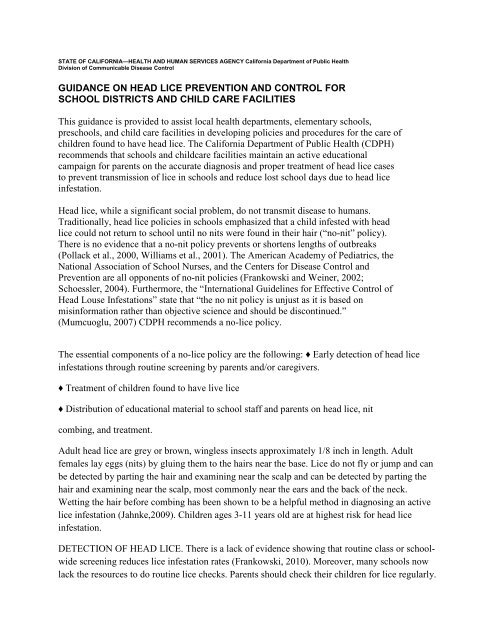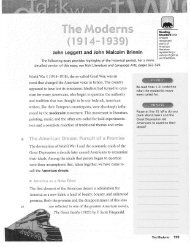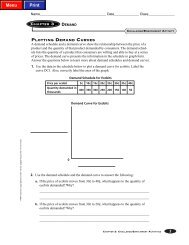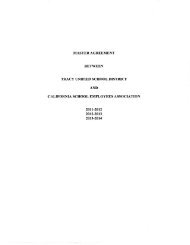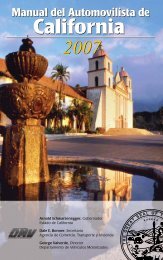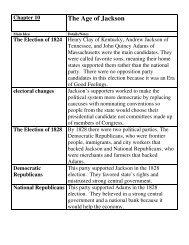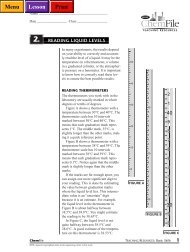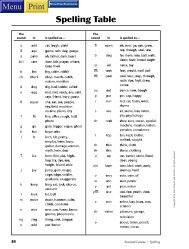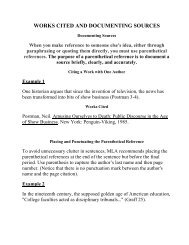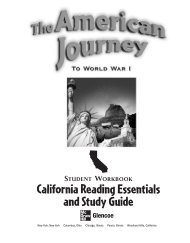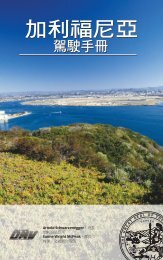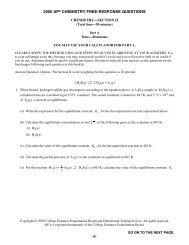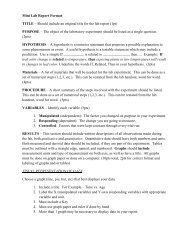Head Lice Information for Parents - Tracy Unified School District
Head Lice Information for Parents - Tracy Unified School District
Head Lice Information for Parents - Tracy Unified School District
You also want an ePaper? Increase the reach of your titles
YUMPU automatically turns print PDFs into web optimized ePapers that Google loves.
STATE OF CALIFORNIA—HEALTH AND HUMAN SERVICES AGENCY Cali<strong>for</strong>nia Department of Public Health<br />
Division of Communicable Disease Control<br />
GUIDANCE ON HEAD LICE PREVENTION AND CONTROL FOR<br />
SCHOOL DISTRICTS AND CHILD CARE FACILITIES<br />
This guidance is provided to assist local health departments, elementary schools,<br />
preschools, and child care facilities in developing policies and procedures <strong>for</strong> the care of<br />
children found to have head lice. The Cali<strong>for</strong>nia Department of Public Health (CDPH)<br />
recommends that schools and childcare facilities maintain an active educational<br />
campaign <strong>for</strong> parents on the accurate diagnosis and proper treatment of head lice cases<br />
to prevent transmission of lice in schools and reduce lost school days due to head lice<br />
infestation.<br />
<strong>Head</strong> lice, while a significant social problem, do not transmit disease to humans.<br />
Traditionally, head lice policies in schools emphasized that a child infested with head<br />
lice could not return to school until no nits were found in their hair (“no-nit” policy).<br />
There is no evidence that a no-nit policy prevents or shortens lengths of outbreaks<br />
(Pollack et al., 2000, Williams et al., 2001). The American Academy of Pediatrics, the<br />
National Association of <strong>School</strong> Nurses, and the Centers <strong>for</strong> Disease Control and<br />
Prevention are all opponents of no-nit policies (Frankowski and Weiner, 2002;<br />
Schoessler, 2004). Furthermore, the “International Guidelines <strong>for</strong> Effective Control of<br />
<strong>Head</strong> Louse Infestations” state that “the no nit policy is unjust as it is based on<br />
misin<strong>for</strong>mation rather than objective science and should be discontinued.”<br />
(Mumcuoglu, 2007) CDPH recommends a no-lice policy.<br />
The essential components of a no-lice policy are the following: ♦ Early detection of head lice<br />
infestations through routine screening by parents and/or caregivers.<br />
♦ Treatment of children found to have live lice<br />
♦ Distribution of educational material to school staff and parents on head lice, nit<br />
combing, and treatment.<br />
Adult head lice are grey or brown, wingless insects approximately 1/8 inch in length. Adult<br />
females lay eggs (nits) by gluing them to the hairs near the base. <strong>Lice</strong> do not fly or jump and can<br />
be detected by parting the hair and examining near the scalp and can be detected by parting the<br />
hair and examining near the scalp, most commonly near the ears and the back of the neck.<br />
Wetting the hair be<strong>for</strong>e combing has been shown to be a helpful method in diagnosing an active<br />
lice infestation (Jahnke,2009). Children ages 3-11 years old are at highest risk <strong>for</strong> head lice<br />
infestation.<br />
DETECTION OF HEAD LICE. There is a lack of evidence showing that routine class or schoolwide<br />
screening reduces lice infestation rates (Frankowski, 2010). Moreover, many schools now<br />
lack the resources to do routine lice checks. <strong>Parents</strong> should check their children <strong>for</strong> lice regularly.
If lice are seen on a child at school the parents should be called to pick up the child at the end of<br />
the school day and be given a copy of the brochure “A Parent’s Guide to <strong>Head</strong> <strong>Lice</strong>”. At home,<br />
all members of the family must be checked <strong>for</strong> head lice. This policy allows the parent to treat<br />
the child overnight. The day following treatment, the child should be re-examined and admitted<br />
to class. If the child is still infested, then the parent should be re-contacted.<br />
While classroom or school-wide notification is not recommended after head lice have been<br />
detected in a student, this policy is at the discretion of the school nurse or administration.<br />
CHRONIC CASES. If a child is found repeatedly infested with head lice <strong>for</strong> six consecutive<br />
weeks or in three separate months of the school year, the child should be deemed to have a<br />
“chronic” head lice case. It is important <strong>for</strong> schools to identify these children since their<br />
continuing infestations may signify other family or socioeconomic problems. These chronic<br />
cases should be reported to the school attendance review board and be addressed by a<br />
multidisciplinary work group. The work group could consist of the school (district) nurse, and<br />
other appropriate individuals to determine the best approach to identifying and resolving the<br />
family problems that impact the child’s chronic louse<br />
infestation and school attendance.<br />
ENVIRONMENTAL CONTROL. Adult lice will die within two days without a blood meal. in<br />
a classroom where head lice are found; actions should be taken if possible to reduce head-tohead<br />
contact (Frankowski, 2010). Always keep each child’s hat and other clothing on separate<br />
hooks and hang each child’s coat on the back of their chair.<br />
Pillows and other classroom items may have nits or lice on them but are unlikely sources of<br />
infestation. These items can be put in a dryer and run on hot <strong>for</strong> 20 minutes, vacuumed, or<br />
placed in sealed plastic bags <strong>for</strong> two weeks to kill hatching lice (nits take six to nine days to<br />
hatch and are unlikely to hatch away from the scalp). Vacuuming infested classrooms once a<br />
day until no children have lice can decrease the remote possibility of lice transmission from the<br />
environment.<br />
At home, bed linens should be laundered (Burkhardt, 2006, Meinking, 1999). Pesticide<br />
application to the school or home environment is not recommended.<br />
TREATMENT. <strong>Parents</strong> need to understand that the most important components of head ice<br />
control are a single treatment with one of the following treatments, then<br />
reapplication if live lice are found seven to ten days later. Nit combing should also be<br />
per<strong>for</strong>med. <strong>Head</strong> lice that are resistant to some of the commonly used insecticides in head<br />
lice shampoos have been found in Cali<strong>for</strong>nia and there<strong>for</strong>e not all lice may be killed by<br />
treatment. Combing and removal of nits may help to reduce the duration of<br />
infestation. CDPH recommends the combination of treatment and nit combing. Several brands<br />
of nit combs are available at local pharmacies. Flea combs also work well <strong>for</strong> nit combing and<br />
can be bought at pet stores. Sometimes it may seem that the treatment used has failed when<br />
actually there may have been: 1) misidentification of substance on the hair shaft as nits (i.e.<br />
dandruff, styling products, etc.), 2) re-infestation, 3) inadequate treatment (used too little<br />
product), or 4) no knowledge that it may take 8-12 hours <strong>for</strong> lice to die after treatment.
Permethrin (i.e. Nix®*) and pyrethrin treatments may be used to kill live lice but may need to<br />
be used again one week later to kill resistant or newly hatched lice. Studies of head lice in<br />
Cali<strong>for</strong>nia indicate that some lice populations are resistant to permethrin Gao et al., 2003;<br />
Yoon et al., 2004). However, there are now non-permethrin based products available <strong>for</strong> head<br />
lice control.<br />
Benzyl Alcohol Lotion (5%) (i.e. Ulesfia®*) is a prescription medication <strong>for</strong> the treatment of<br />
head lice in patients 6 months of age and older. However, Benzyl alcohol does not kill nits and<br />
treatment should be repeated in 7 days to kill emerged lice (Frankowski, 2010; Meinking,<br />
2010).<br />
Ovide®*(0.5% Malathion) is available by prescription. Ovide is an effective product to kill<br />
lice and their nits on children 24 months of age and above. Ovide is flammable so parents<br />
must not use hairdryers or smoke when applying this product (Meinking et al,<br />
2001; Meinking et al, 2002; Frankowski, 2010).<br />
Spinosad (0.9%) (Natroba ®*) is a prescription treatment <strong>for</strong> children 4 years of age and above.<br />
Spinosad is derived from a soil-dwelling bacterium and works to “over-stimulate” ice and nits<br />
into paralysis and death (McCormack, 2011).<br />
Sklice®* (0.5% Ivermectin) is a prescription treatment <strong>for</strong> children 6 months of age and<br />
above. Ivermectin is derived from a soil bacterium and causes paralysis and death in ice and<br />
nits.<br />
The Lousebuster®* is a device designed to deliver heated air at high flow to the scalp and<br />
hair to kill lice and nits. Treatment takes 30 minutes (Bush, 2011).<br />
There is no conclusive scientific evidence to support the use of products such as vinegar,<br />
isopropyl alcohol, enzyme-based compounds, tea tree oil, or other alternative products<br />
advertised to dissolve the glue on the nits (to ease their removal) or kill the nits. Similarly,<br />
there are no conclusive scientific data to support claims that mayonnaise, olive oil, melted<br />
butter, petroleum jelly, or other alternative products on<br />
he hair “suffocate” the nits and lice. Drowning lice is also an ineffective way to kill lice<br />
Takano-Lee et al., 2004). Natural products (i.e. herbal products) are not regulated <strong>for</strong> safety<br />
by the U.S. Food and Drug Administration.<br />
Please contact your local health department <strong>for</strong> more in<strong>for</strong>mation. The list of references cited in<br />
this document is attached. These guidelines, the brochure “A Parent’s Guide to <strong>Head</strong> <strong>Lice</strong>” (in<br />
English and Spanish) and other CDPH publications can be found on the<br />
Recommendations by state and federal experts and existing standards of practice outlined in this<br />
document are intended to provide guidance to individuals and agencies involved with head lice<br />
prevention and control in Cali<strong>for</strong>nia. The in<strong>for</strong>mation provided in this document are recommendations<br />
provided <strong>for</strong> in<strong>for</strong>mational purposes only and are not intended to be regulatory in effect.<br />
Literature Cited<br />
1. Burkhardt, C.N. and C.G. Burkhardt. 2006. Fomite transmission in head lice.
Journal of American Academy of Dermatology. 1-4.<br />
2. Bush, S.E., Rock, A.N., Jones, S.L., Malenke, J.R., and D.L. Clayton. 2011.<br />
Efficacy of Louse Buster, a New Medical Device <strong>for</strong> Treating <strong>Head</strong> <strong>Lice</strong><br />
(Anoplura: Pediculidae). Journal of Medical Entomology. 48 (1): 67-72.<br />
3. Frankowski, B. L., and Weiner, L. B. 2002. <strong>Head</strong> <strong>Lice</strong>. Pediatrics. 110(3): 638-<br />
643.<br />
4. Frankowski, B.L., Bocchini, J.A. Jr., and the Council on <strong>School</strong> Health and<br />
Committee on Infectious Diseases. Clinical Report <strong>Head</strong> <strong>Lice</strong>. 2010. Pediatrics<br />
126: 392-403.<br />
5. Gao, J-R., Yoon, K.S., Lee, S.H., Takano-Lee, M., Edman, J.D.,<br />
Meinking, T.L., Taplin, D., J.M. Clark. 2003. Increased frequency of the T929I<br />
and L932F mutations associated with knockdown resistance in permethrinresistant<br />
populations of the human head louse, Pediculus capitis, from<br />
Cali<strong>for</strong>nia, Florida, and Texas. Pesticide Biochemistry and Physiology. 77:115-<br />
124.<br />
6. Jahnke, C., Bauer, E., Hengge, U.R., and H. Feldmeier. 2009. Accuracy of<br />
Diagnosis of Pediculosis Capitis. Archives of Dermatology. 145 (3): 309-313.<br />
7. McCormack, P.L. 2011. Spinosad: in pediculosis capitis. Journal of Clinical<br />
Dermatology. 12(5): 349-353.<br />
8. Meinking, T.L., Clineschmidt, C.M., Chen, C., Kolber, M. A., Tipping, R.W.,<br />
Furlek, C.I., Villar, M.E., C.A. Guzzo. 2002. An observer blinded study of 1%<br />
permethrin crème rinse with and without adjunctive combing in patients with<br />
head lice. The Journal of Pediatrics. 141: 665-670.<br />
9. Meinking, T.L., Entzel, P., Villar, M.E., Vicaria, M., Lernard, G.A, S. L. Porcelain.<br />
2001. Comparative efficacy of treatments <strong>for</strong> Pediculus capitis<br />
infestations. Archives of Dermatology. 137: 287-292.<br />
10. Meinking, T.L., Serrano, L., Hard, B., Entzel, P., Lernard, G., Rivera, E.,<br />
Villar, M.E. 2002. Comparative in vitro pediculicidal efficacy of treatments in a<br />
resistant head lice population in the United States. Archives of Dermatology.<br />
138: 220-<br />
224.<br />
11. Meinking, T.L., Villar, M.E, Vicaria, M., Eyerdam, D.H., Paquet, D., Mertz-<br />
Rivera, K, Rivera, H.F., Hirart, J., and Reyna, S. 2010. The clinical trials<br />
supporting benzyl alcohol 5% (Ulesfia): a safe and effective treatment or head<br />
lice (pediculosis humanus capitis). Pediatric Dermatology. 27(1): 19-24.
12. Mumcuoglu, K.Y., Barker, S.C., Burgess, I.F., Combescot-Lang, C.,<br />
Dalgleish, R.C., Larsen, K.S., Miller, J., Roberts, R.J., and A. Taylan-Ozkan.<br />
2007. International Guideline <strong>for</strong> Effective Control of <strong>Head</strong> <strong>Lice</strong> Infestations.<br />
Journal of Drugs in Dermatology. 6(4): 409-414.<br />
13. Pollack, R.J., Kiszeweski, A.E., A. Spielman. 2000. Over diagnosis<br />
and consequent mismanagement of head louse infestations in North<br />
America. Pediatric Infectious Diseases. 19: 689-693.<br />
14. Schoessler, S.Z. 2004. Treating and managing head lice: the<br />
school nurse perspective. American Journal of Managed Care. 10(9<br />
Suppl): S273-6.<br />
15. Takano-Lee, M., Edman, J.D., Mullens, B.A., Clark, J.M. 2004. Home<br />
remedies to control head lice: assessment of home remedies to control the<br />
human head louse, Pediculus humanus capitis (Anoplura: Pediculidae).<br />
Journal of Pediatric Nursing. 19(6): 393-398.<br />
16. Williams, L.K., Reichert, A., MacKenzie, W.R., Hightower, A.W., P.A. Blake.<br />
2001. <strong>Lice</strong>, nits, and school policy. Pediatrics. 107 (5): 1011-1015.<br />
17. Yoon, K.S., Gao, J-R., Lee, S. H., Coles, G.C., Meinking, T.L., Taplin, D.,<br />
Edman, J.D., Takano-Lee, M., J.M. Clark. 2004. Resistance and cross-resistance<br />
to insecticides in human head lice from Florida and Cali<strong>for</strong>nia. Pesticide<br />
Biochemistry and Physiology. 80: 192-201.<br />
5


